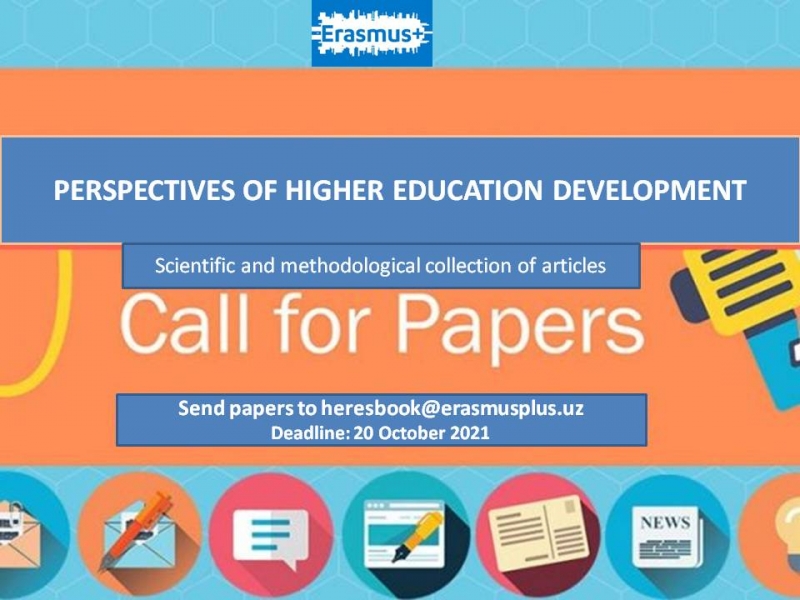PERSPECTIVES OF HIGHER EDUCATION DEVELOPMENT № 10
Scientific and methodological journal of the Erasmus+ Higher Education Reform Experts team – HEREs
Included in the list of scientific journals recommended by the Higher Attestation Commission of the Republic of Uzbekistan
The purpose of the journal is to improve the efficiency of the educational process in the Republic of Uzbekistan by analyzing and informing about progressive methods, achievements, trends and problems in the field of higher education.
The subjects of the journal:
• Modern challenges for the higher education system of the Republic of Uzbekistan
• Credit-modular system in HE
• Educational platforms as a means of intensifying the training of highly qualified personnel
• University autonomy
• Innovative methods in higher education
• Erasmus+ Programme
• Problems and prospects of investment in higher education
• Experience of foreign countries in the development of higher education
• Related topics that reflect the development of higher education
REQUIREMENTS FOR ARTICLES
1. Content requirements.
The journal claims to become one of the leading international scientific journals on the development of higher education in the Republic, with a subsequent increase in frequency and circulation, as well as its inclusion in the list of analytical systems Scopus and Web of Science.
Accordingly, the requirements for the articles of the journal are brought to international standards for the design of scientific articles. The review will be more qualified and objective. We ask all authors to support the journal with their scientific articles that meet international standards both in format and in content.
2. Requirements for the design of articles:
1) "Information about the authors" (in a separate file in the original language?)
• FULL name (in full)
• Position and place of work
• City, country
• Academic title, academic degree,
• Field of scientific research (no more than 2 lines)
• Email address
2) Articles lead to the standard form, according to the scheme:
ARTICLE STRUCTURE:
In the original language:
• Full name (in lowercase)
• Title of the article in CAPITAL letters
• Abstract
• Keywords
• Article
• List of references
In English:
• FULL name
• Title of the article in CAPITAL letters
• Abstract
• Keywords
FORMAT
- Number of pages - from 10 to 15, interval-1.0
- Font: Times New Roman, 14
- Abstract in the language of the article and abstract in English
- Keywords (from 5 to 7 words or phrases)
- Page margins: top, bottom, left , right-2.5 cm
- Page numbering in the lower right corner
Abstract requirements (in the original language and in English)
The abstract should be an independent text and should be devoted to the article that the research conducted, not to the subject of the study as a whole. It is a brief but informative summary of the article. In the abstract, it is not allowed to use formulas, abbreviations, references and literature review.
Important! The abstract should be written in one paragraph in the original language - 500-600 characters (about 100 words), in English – 1200-1250 characters (about 200 words).
Requirements for the List of References
The list of references is given in alphabetical order, with end-to-end numbering. References in the text from the list of references are made in square brackets, for example, [12]. The list of references should contain at least 10 sources. All positions of the list should be referenced in the text of the article and vice versa – all the mentioned literature should be listed in the list of references. When registering, adhere to the relevant standards of bibliographic description (for example, GOST 7.1- 2003, etc.).
Example of an ABSTRACT to an article
DISTANCE EDUCATION.
DEVELOPMENT DURING A PANDEMIC
(ФИО на английском)
Abstract. The COVID-19 pandemic has made adjustments not only to the health care system and our personal lives, but also to the education system. On the one hand, there is an intention to maintain good health of students and teaching staff, on the other hand, to keep teaching and learning process at the proper level. To solve the problem, more than ever, we need the means and methods of distance learning and education.
The purpose of the article is to provide some recommendations for decision-making on the development of distance education (DE) during the COVID-19 pandemic, based on the analysis of the experience of the EU, USA, China and other countries. In addition, the author himself experienced all the negative and positive aspects of conducting classes online and shared his opinion.
Analysis of this "short-term" period shows that DE has its pros and cons. Advantages: saving time and money; reducing the risk of getting sick; development of DE technologies; enhancement of teachers to prepare e-courses; equal opportunities for students to gain knowledge. Disadvantages: lack of direct contact with students; difficulty of individual work and in groups; "Presence Effect" of students; activity of unscrupulous teachers; complexity of knowledge assessment; technological inequality among students; decreased activity of scientific research.
The study of the experience shows that this period will make us reconsider the attitude both to distance learning and to the system of distance education as a whole. The article will be useful for university administrators and teachers who organize and conduct DE courses during the COVID-19 pandemic and make plans for future DE development.
Keywords: distance education, COVID-19 pandemic, information technologies in education, e-courses, online training.
The deadline for submitting articles is October 20, 2021.
The Editorial Board has the right to reject an article if it does not meet the requirements of the subject and design. Copies are not returned.
